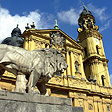BAROQUE CHURCHES OF MUNICH
I See Your Gothic and Raise You A Rococo
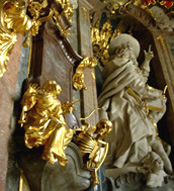 Cologne
has its great gothic cathedral masterpiece, Berlin has it bombed symbolic
Blaukirche, and
Hamburg its
Michel, indeed almost any village
in Germany starts with a church surrounded by a town, but no city in
Germany is perhaps as much defined by its
churches as Munich. While the north of Germany embraced Luther’s
reformation with a vengeance, the Bavarian south, with its ties to the
Holy Roman Empire, retained
its Catholic influence. Though Munich's great churches date from the
middle ages to the Renaissance and grand époque, most of them
bear the unique design marks of the Baroque period when the city was
at its height of wealth and power.
Cologne
has its great gothic cathedral masterpiece, Berlin has it bombed symbolic
Blaukirche, and
Hamburg its
Michel, indeed almost any village
in Germany starts with a church surrounded by a town, but no city in
Germany is perhaps as much defined by its
churches as Munich. While the north of Germany embraced Luther’s
reformation with a vengeance, the Bavarian south, with its ties to the
Holy Roman Empire, retained
its Catholic influence. Though Munich's great churches date from the
middle ages to the Renaissance and grand époque, most of them
bear the unique design marks of the Baroque period when the city was
at its height of wealth and power.
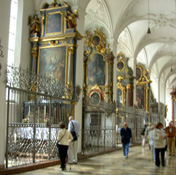 Peterskirche or
St. Peters Catholic Cathedral
is the oldest parish church in Munich dating from the Romanesque period.
The original church was
mostly destroyed
by
a fire in 1327 and is earlier architecture rebuilt in the Gothic style.
The church is noted for its five gothic paintings
along the nave and high Baroque altar. The
Peterskirche bell tower which provides the 360 degree city view was
added in the 1600s.
Peterskirche or
St. Peters Catholic Cathedral
is the oldest parish church in Munich dating from the Romanesque period.
The original church was
mostly destroyed
by
a fire in 1327 and is earlier architecture rebuilt in the Gothic style.
The church is noted for its five gothic paintings
along the nave and high Baroque altar. The
Peterskirche bell tower which provides the 360 degree city view was
added in the 1600s. 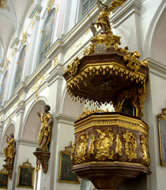 Music
concerts
are
performed
at Peterskirche, check the schedule in the vestibule. Should
climbing a bell tower for a view of the city, be your idea of getting
to know the layout of the city, St. Peters Cathedral next to the
Viktualien
Markt, just off the central Marienplatz square is the best bet. It
allows a look down on the market square and a vantage
point for the twirling figures of the Rathaus Glockenspiel. From St.
Peters you look across the old town to the twin onion domes tower of
Munich’s symbolic Frauenkirche. This is the view that’s on
so many postcards. But prepare for a line and a lot of steps.
Music
concerts
are
performed
at Peterskirche, check the schedule in the vestibule. Should
climbing a bell tower for a view of the city, be your idea of getting
to know the layout of the city, St. Peters Cathedral next to the
Viktualien
Markt, just off the central Marienplatz square is the best bet. It
allows a look down on the market square and a vantage
point for the twirling figures of the Rathaus Glockenspiel. From St.
Peters you look across the old town to the twin onion domes tower of
Munich’s symbolic Frauenkirche. This is the view that’s on
so many postcards. But prepare for a line and a lot of steps.
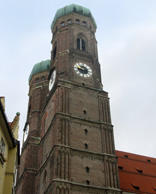 The
Frauenkirche or
Cathedral of the Blessed Lady is the largest church in Munich, located
a few
blocks to the west of the Town
Hall. Its twin
bell towers stand out above the city rooftops. A city ordinance requires
than no building in central Munich be higher than 100 meters tall,
so the skyline has remained with the high rise offices that have
affected
the view of other Germany cities. The interior of the Frauenkirche
was severely damaged in WWII bombing and remains a little plain,
The
Frauenkirche or
Cathedral of the Blessed Lady is the largest church in Munich, located
a few
blocks to the west of the Town
Hall. Its twin
bell towers stand out above the city rooftops. A city ordinance requires
than no building in central Munich be higher than 100 meters tall,
so the skyline has remained with the high rise offices that have
affected
the view of other Germany cities. The interior of the Frauenkirche
was severely damaged in WWII bombing and remains a little plain, 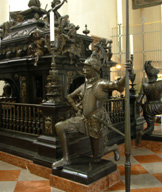 but the
skyward
reaching gothic arches to the highest ceiling are imposing. Most
striking is the burial bronze sculpture of the tomb monument
of Holy
Roman Emperor Louis IV. When standing at the door, the columns of the
nave hide the windows and near the door is the Devil's Footstep (Teufelstritt).
The black mark in the floor appearing like a footprint with a hooked
tail is said to be where the devil stomped his foot after discovering
he’d been tricked by the builder for a bet on his soul with Lucifer
he would build a church with no windows, but created a cathedral filled
with God’s light anyway. The Frauenkirch clock tower is the next
most popular to climb (and a few more steps).
but the
skyward
reaching gothic arches to the highest ceiling are imposing. Most
striking is the burial bronze sculpture of the tomb monument
of Holy
Roman Emperor Louis IV. When standing at the door, the columns of the
nave hide the windows and near the door is the Devil's Footstep (Teufelstritt).
The black mark in the floor appearing like a footprint with a hooked
tail is said to be where the devil stomped his foot after discovering
he’d been tricked by the builder for a bet on his soul with Lucifer
he would build a church with no windows, but created a cathedral filled
with God’s light anyway. The Frauenkirch clock tower is the next
most popular to climb (and a few more steps).
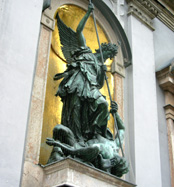 St.
Michaels Church is a few blocks down Kaufinger
Strass, marked by its bronze sculpture of the archangel Michael's victory
over
the fallen
one. He's unfortunately covered by a thin net as are most of Munich's
exterior architecture sculptures. Good may triumph over evil, but
the city's still locked in eternal battle with pigeons. Munich's
Sankt
Michael is the largest Renaissance era church north of the Alps.
Constructed by Duke Wilhelm V of Bavaria around 1590, it was
his response to Martin
Luther's reformation in the north (see Martin
Luther's Wittenberg). The interior
of the church is akin to Hamburg’s St. Michaels (see Hamburg
Michaelskirche) and influenced much of the early Baroque
style common throughout southern
Germany (see Ettal
Abbey Basilica).
St.
Michaels Church is a few blocks down Kaufinger
Strass, marked by its bronze sculpture of the archangel Michael's victory
over
the fallen
one. He's unfortunately covered by a thin net as are most of Munich's
exterior architecture sculptures. Good may triumph over evil, but
the city's still locked in eternal battle with pigeons. Munich's
Sankt
Michael is the largest Renaissance era church north of the Alps.
Constructed by Duke Wilhelm V of Bavaria around 1590, it was
his response to Martin
Luther's reformation in the north (see Martin
Luther's Wittenberg). The interior
of the church is akin to Hamburg’s St. Michaels (see Hamburg
Michaelskirche) and influenced much of the early Baroque
style common throughout southern
Germany (see Ettal
Abbey Basilica).
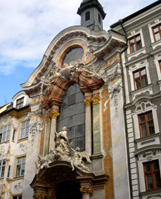 The Asamkirch is
Munich’s
hidden gem. Much less visited than the others along the main tourism
walks of Kaufinger, officially
the Church
of Saint Johan Nepomuk, nicknamed for the rich fellow who had it
built as a private worship spot, this little church,
tightly sandwiched between two 1700's buildings is
a rococo masterpiece.
The Asamkirch is
Munich’s
hidden gem. Much less visited than the others along the main tourism
walks of Kaufinger, officially
the Church
of Saint Johan Nepomuk, nicknamed for the rich fellow who had it
built as a private worship spot, this little church,
tightly sandwiched between two 1700's buildings is
a rococo masterpiece. 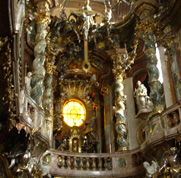 Impossibly ornate with great paintings of God the Father and Christ
crucified, and the fraternity
of angels alter. A step in the door will stun for a moment, with
its gold gilt filigree skeletons and saints. It is located on Sendlinger
Strasse,
the street south from Marienplatz to Sendlingertor. Unfortunately
for all the beauty of the artwork and gilt, this is a church with
few windows
and its splendors are often viewed in the dim light, unless a service
is in progress, when it comes alive.
Impossibly ornate with great paintings of God the Father and Christ
crucified, and the fraternity
of angels alter. A step in the door will stun for a moment, with
its gold gilt filigree skeletons and saints. It is located on Sendlinger
Strasse,
the street south from Marienplatz to Sendlingertor. Unfortunately
for all the beauty of the artwork and gilt, this is a church with
few windows
and its splendors are often viewed in the dim light, unless a service
is in progress, when it comes alive.
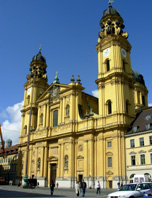 The Theatinerkirche,
at the edge of the Odeonsplatz, across from the Residence Palace
(see Residence
Jewels and Emperors)
is the most visually
remarkable
from the outside. Its
yellow and black exterior standing out in the sunlight, the Theatiner
Church
is perhaps
Munich’s
church with the most interesting history, and the latest of the city's
great churches. It was ordered built by the Elector
Ferdinand for
The Theatinerkirche,
at the edge of the Odeonsplatz, across from the Residence Palace
(see Residence
Jewels and Emperors)
is the most visually
remarkable
from the outside. Its
yellow and black exterior standing out in the sunlight, the Theatiner
Church
is perhaps
Munich’s
church with the most interesting history, and the latest of the city's
great churches. It was ordered built by the Elector
Ferdinand for 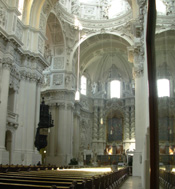 his wife Henriette,
in honor of her giving birth to a male heir to the throne of Bavaria
(after several girls). It was begun in 1663 and ultimately completed
100 years later. It was designed by Italian architects and is in
an Italian influenced high-baroque style. The interior is noted for
its wide open
space, dome and white stucco designs, with contrasting black pulpit.
The Theatinerkirche has a chapel where Bavaria's great unifier king,
Maximillian II, is buried and the tomb is the burial place of several
of the great Wittelsbach dynasty's figures.
his wife Henriette,
in honor of her giving birth to a male heir to the throne of Bavaria
(after several girls). It was begun in 1663 and ultimately completed
100 years later. It was designed by Italian architects and is in
an Italian influenced high-baroque style. The interior is noted for
its wide open
space, dome and white stucco designs, with contrasting black pulpit.
The Theatinerkirche has a chapel where Bavaria's great unifier king,
Maximillian II, is buried and the tomb is the burial place of several
of the great Wittelsbach dynasty's figures.
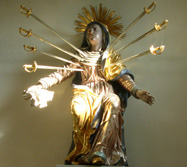 Not
truly in Munich, but in Dachau near the Oberschleissheim Palaces,
the Church of St. Jakob in the old town village
of Dachau (see Dachau
Palace and Garden),
has a striking example of that peculiarly Baroque period iconic vision
of St Mary
with her heart pierced by the swords of seven sorrows. Worth a pilgrimage
if
visiting the sorrowful concentration camp (see Dachau
Holocaust Museum)
or the Wittelsbach summer palace. © Bargain
Travel Europe
Not
truly in Munich, but in Dachau near the Oberschleissheim Palaces,
the Church of St. Jakob in the old town village
of Dachau (see Dachau
Palace and Garden),
has a striking example of that peculiarly Baroque period iconic vision
of St Mary
with her heart pierced by the swords of seven sorrows. Worth a pilgrimage
if
visiting the sorrowful concentration camp (see Dachau
Holocaust Museum)
or the Wittelsbach summer palace. © Bargain
Travel Europe
Find
best hotel and vacation deals in Munich
at Trip Advisor
Web
Info
Munich Tourism
These articles and photos are copyrighted and the sole property of Bargain Travel Europe and WLPV, LLC. and may not be copied or reprinted without permission.
See Also:
ENGLISCHER
GARTEN - MUNICH'S CENTRAL PARK
MUNICH'S
OKTOBERFEST - THE BIGGEST BEER PARTY
MUNICH'S PINAKOTHEKS ART MUSEUMS

